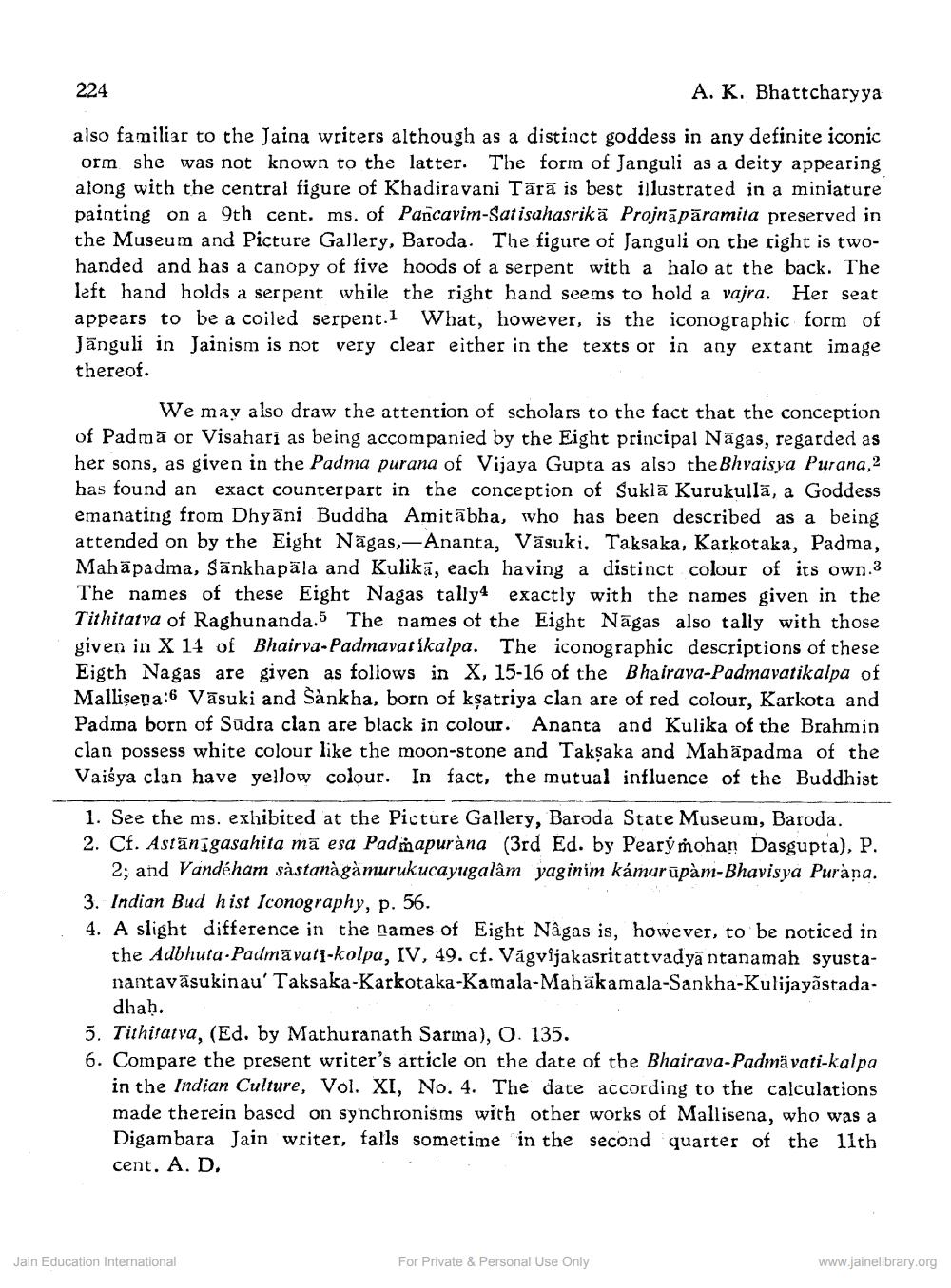Book Title: Introduction to Iconography of Jain Goddess Padmavati Author(s): A K Bhattacharya Publisher: Z_Jinvijay_Muni_Abhinandan_Granth_012033.pdf View full book textPage 6
________________ 224 A. K. Bhattcharyya also familiar to the Jaina writers although as a distinct goddess in any definite iconic orm she was not known to the latter. The form of Janguli as a deity appearing along with the central figure of Khadiravani Tärä is best illustrated in a miniature painting on a 9th cent. ms. of Pancavim-Satisahasrikä Projnāpāramita preserved in the Museum and Picture Gallery, Baroda. The figure of Janguli on the right is twohanded and has a canopy of five hoods of a serpent with a halo at the back. The left hand holds a ser pent while the right hand seems to hold a vajra. Her seat appears to be a coiled serpent. What, however, is the iconographic form of Jānguli in Jainism is not very clear either in the texts or in any extant image thereof. We may also draw the attention of scholars to the fact that the conception of Padmā or Visahari as being accompanied by the Eight principal Nägas, regarded as her sons, as given in the Padma purana of Vijaya Gupta as also the Bhvaisya Purana, 2 has found an exact counterpart in the conception of Suklā Kurukulla, a Goddess emanating from Dhyāni Buddha Amitābha, who has been described as a being attended on by the Eight Nāgas,- Ananta, Väsuki, Taksaka, Karkotaka, Padma, Mahāpadma, Sānkhapala and Kulikā, each having a distinct colour of its own.3 The names of these Eight Nagas tally4 exactly with the names given in the Tithitatva of Raghunanda. The names of the Eight Nāgas also tally with those given in X 14 of Bhairva-Padmavat ikalpa. The iconographic descriptions of these Eigth Nagas are given as follows in X, 15-16 of the Bhairava-Padmavatikalpa of Mallişena:6 Vasuki and Sankha, born of ksatriya clan are of red colour, Karkota and Padma born of Sudra clan are black in colour. Ananta and Kulika of the Brahmin clan possess white colour like the moon-stone and Takşaka and Mahäpadma of the Vaiśya clan have yellow colour. In fact, the mutual influence of the Buddhist 1. See the ms. exhibited at the Picture Gallery, Baroda State Museum, Baroda. 2. Cf. Astänīgasahita mā esa Padmapurana (3rd Ed. by Pearý mohan Dasgupta), P. 2; and Vandéham sastanagamurukucayugalâm yaginim kámarūpam-Bhavisya Purana. 3. Indian Bud hist Iconography, p. 56. 4. A slight difference in the names of Eight Nâgas is, however, to be noticed in the Adbhura.Padmävati-kolpa, IV, 49. cf. Vágvîjakasritattvadyāntanamah syustanantavāsukinau' Taksaka-Karkotaka-Kamala-Mahäkamala-Sankha-Kulijayāstada dhah. 5. Tithitatva, (Ed. by Mathuranath Sarına), O. 135. 6. Compare the present writer's article on the date of the Bhairava-Padmavati-kalpa in the Indian Culture, Vol. XI, No. 4. The date according to the calculations made therein based on synchronisms with other works of Mallisena, who was a Digambara Jain writer, falls sometime in the second quarter of the 11th cent. A. D. Jain Education International For Private & Personal Use Only www.jainelibrary.orgPage Navigation
1 ... 4 5 6 7 8 9 10 11
